Project Japan: Metabolism Talks
By Rem Koolhaas & Hans Ulrich Obrist
Publisher: Taschen

Contents
007 Acknowledgments
011 Rem Koolhaas Movement (1)
017 Hans Ulrich Brist Movement (2)
022 Note on the text
024 Arata Isozaki
056 Tabula Rasa
084 Toshiko Kato
102 Tange Lab
128 Kiyonori Kikutake
174 Birth of a Movement
206 Metabolism 1960
222 Noboru Kawazoe
266 Tokyo Bay
294 Fumihiko Maki
334 On the Land, on the Sea, in the Air
372 Kisho Kurokawa
440 Media Architects
474 Kenji Ekuan
506 Expo ’70
550 Takako Tange Noritaka Tange
590 Expansion/Exile
638 Atsushi Shimokobe
660 Project Japan
696 Postscript: Toyo Ito
699 Project Japan 1940-1985: Timeline
706 Image Credits
710 Index
717 Cast of Characters

OMA sent us an absolutely fascinating book that tells the history of the Japanese architecture movement known as Metabolism. “Between 2005 and 2011, architect Rem Koolhaas and curator Hans Ulrich Obrist interviewed the surviving members of Metabolism, together with dozens of their mentors, collaborators, rivals, critics, proteges, and families. The result is a vivid documentary of the last avant-garde movement and the last moment that architecture was a public rather than a private affair…” You can see a few of the iconic buildings from the Metabolism movement here on ArchDaily: works by Kenzo Tange and Kisho Kurokawa’s Nakagin Capsule Tower.

If you are not familiar with Japan’s architectural history during the 1930s then the beginning of this book is eye-opening. Architects, including the future leaders of the Metabolism movement, had their eyes on designing utopias in the newly conquered lands of China, Korea, Mongolia, Thailand, Vietnam, Laos, Burma, the Philippines, and Indonesia. They envisioned their designs arising out of a tabula rasa. Ironically, it would be the wholesale destruction of Japan during World War II that would provide these architects with that “tabula rasa”. Interestingly, when Koolhaas interviews Arata Isozaki, you discover that Kenzo Tange never spoke of the two competitions he won during the war years and the Hiroshima Peace Memorial Park.






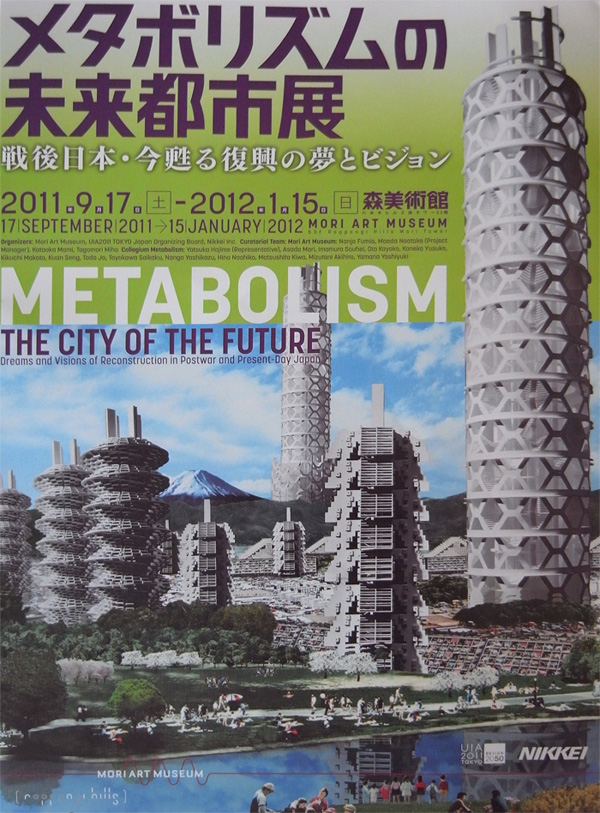
'metabolism - the city of the future' exhibition poster
in tokyo, japan, the mori art museum recently hosted a special talk event between dutch architect and pritzker prize laureate rem koolhaas of OMA and the museum director nanjo fumio. coinciding with the ongoing exhibition
'metabolism, the city of the future: dreams and visions of reconstruction in postwar and present-day japan', the topic of discussion addressed the importance and presence of the metabolists within the post world war climate. these individuals were catalysts to the metabolism movement which was initiated by visionary japanese architects including kurokawa kisho and kikutake kiyonori. this group which emerged at the time supported rapid economic growth, population increases and expansions of cities. koolhaas' new publication 'project japan: metabolism talks', released on october 28th, 2011, analyzes the importance of these individuals through a lens of the architectural scene of today.
faced with difficult decisions in regards to the nation's post-disaster reconstruction efforts, rem referenced specific works by kurokawa including the 'nakagin capsule tower building', a residential and office tower comprised of modular units located in tokyo. built in 1972, the structure demonstrates the success and longevity of these construction methods as it is still in use today without the replacement of any capsules.
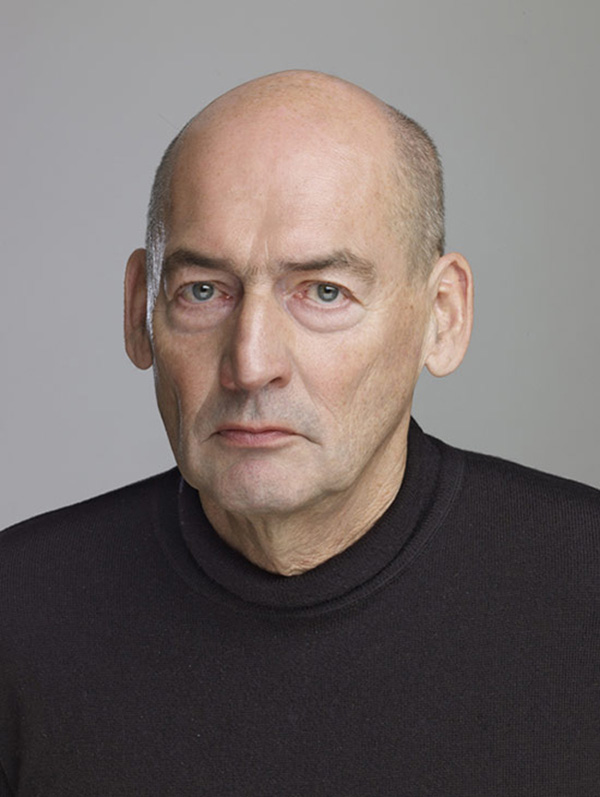
rem koolhaas
image courtesy of biennale di venezia
during the event, rem koolhaas stated:
'if I look at the global situation now, it's my personal conviction that the level of architecture in japan is higher
than in rest of the world. and if you were to think why that is so, the answer is obviously because there has been the presence of a group of architects that were exceptionally gifted, and who also worked together as a group.
if you look at the current landscape of architecture around the world, you see a number of individuals, and those individuals almost never talk to each other. in fact, they're constantly competing with each other and there is not even a remote sense of an architectural community.
moreover, it is very clear that the initiative in culture is now switching from the west to asia. and for that reason, I think it's very interesting to look at how the metabolists, who actively participated in the ending of the western hegemony of architecture, succeeded in establishing their position.'
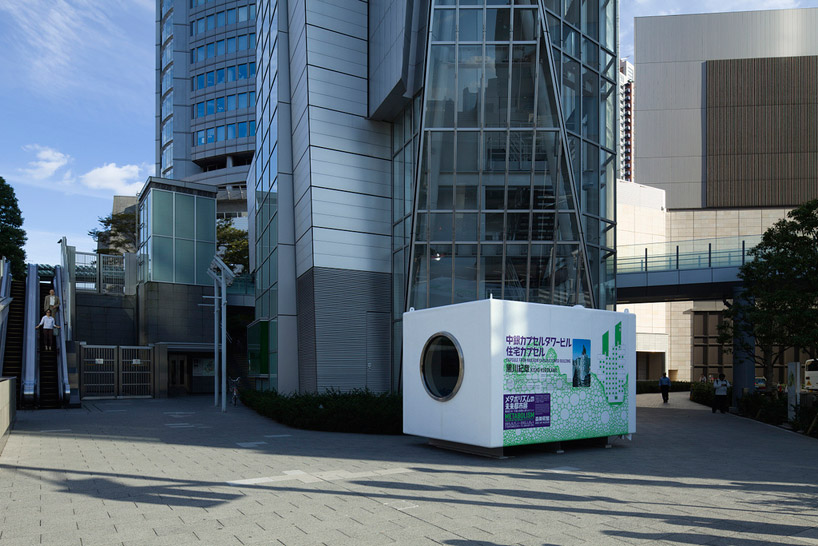
nakagin capsule tower building (1972) by kurokawa kisho on display at the mori art museum
image © watanabe osamu
'when you start a movement, it's like a crime: you have to have a motive. and the more compelling the motive,
the more successful the crime or the movement. so I think that it was a brilliant choice by the metabolists to take the metaphor of metabolism as the motive, because it gives the sense of a biological inevitability.
if you look at the work of kurokawa for instance, he seems to read metabolism not as a linear push for ever bigger and larger projects, but more as an ability to transform at the biological level. I think that he put forward many ideas that are very subtle in terms of how nature could be used or how architecture could be sustainable, ideas which are major issues in architecture now.
but more to the point, while the half of the world consisting of developed countries is in a process of stagnation, the other half continues to grow incredibly quickly. and in that sense, I'd say that there's still an urgent necessity today to think about how to not only accommodate growth, but to channel it in a way that is productive. from this point of view too, I believe looking at a movement like metabolism is very important.' - rem koolhaas
designboom will publish a few articles on the exhibition. please stay tuned.
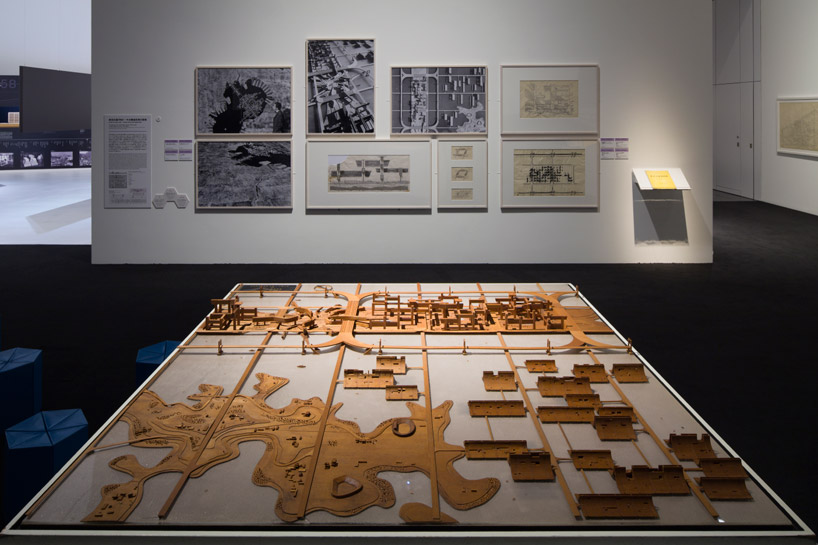
exhibit installation
image © watanabe osamu
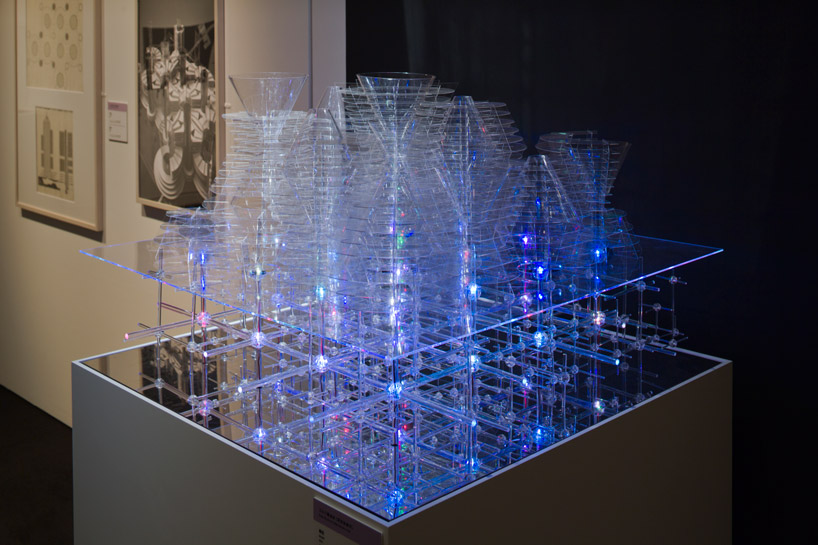
model of golgi structure (high density city)1967/2011 by maki fumihiko within the exhibition
image © watanabe osamu
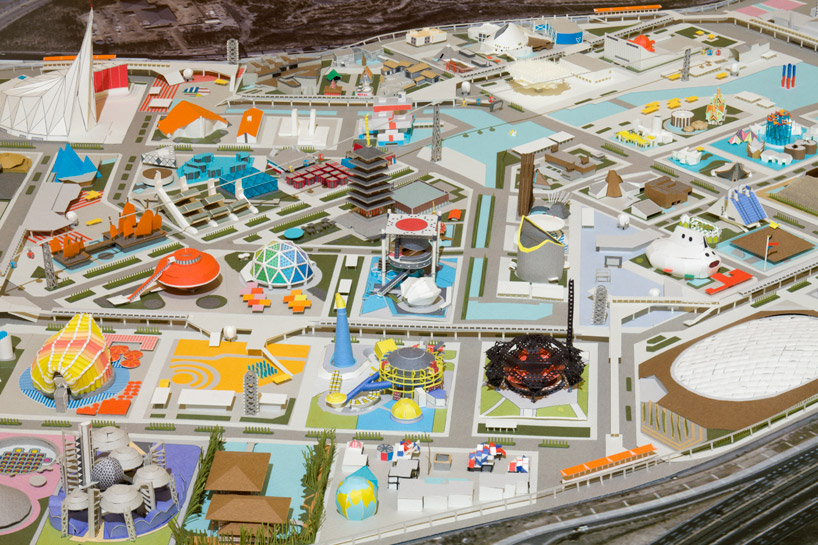
master plan and master design of trunk facilities 2011 by tange kenzo + nishiyama uzo within the exhibition
image © watanabe osamu
“Architecture is a deeply contradictory profession. Its actions intersect with a huge range of unrelated domains; at the same time - its essence to build - is so complex, that it requires extreme focus and concentration. Sadly therefore, it is largely inhabited by two human typologies, “builders” and “thinkers,” united in mutual disdain. Kenzo Tange was both.
Tange died in 2005, the very year we began our interviews, and had withdrawn from public life almost a decade earlier. Like Tokyo, a mass surrounding a central void, this mass of conversation is constructed in his absence. But it is a book about him. Without Tange, no Metabolism.”
Rem Koolhaas

Photo © Kikutake Architects
1958 Nascent Metabolists, and their mentor Kenzo Tange, gather at Kikutake’s housewarming party for his recently completed Sky House.
Hans Ulrich Obrist: With Metabolism, it was a joint manifesto, or rather, a polyphony of voices. There wasn’t one manifesto which everybody signed - or was there? It would be really interesting to identify the glue of this movement, and to know what it was that the writers in the group held in common.
Kiyonori Kikutake: The person who brought us together and who unified us was Noboru Kawazoe. He was a critic and the editor of a magazine called Shinkenchiku (Japan Architect), and he worked hard to tie us together in a single whole. He was our leader, our lynchpin. I hardly knew any of the other architects who became Metabolists. And it is worth adding Kawazoe’s wife was our editor, and whenever she said gather around, we all hurried right over.

Photo © Kiyonori Kikutake
Kiyonori Kikutake, Ikebukuro Plan (1962).
“By giving them rides in my car I was showing them exactly what industrial design was all about. They’d often comment on how constrained architecture was. Kikutake would complain that architecture is no movement, it’s not dynamic...”
Kenji Ekuan

Photo © Kenji Ekuan
Kenji Ekuan, Dwelling City, 1964. Collage.
“It was a group of very strong egos, so we got into any number of fights along the way....”
Noburo Kawazoe
“I thought they were like children, so I thought it was my task to raise them...As a parent.”
Atsushi Shimokobe
“We always feel...not pressure necessarily, but an urgency from tradition...”
Fumihiko Maki
“Architects were living in such a small world and I thought this was foolish...”
Kisho Kurakawa

Photo © Kisho Kurokawa
Kisho Kurokawa, Helix City, 1962.
“The only doubt I had about the Metabolists was that these architects had no skepticism toward their utopia; they represented only a form of progressivism. I thought they were too optimistic. They really believed in technology, in mass production; they believed in systematic urban infrastructure and growth.”
Arata Isozaki

Photo © Asada Collection, Tohoku University of Art & Design, Library
The World Design Conference, Tokyo, 1960
Toshiko Kato
Kenzo Tange first wife.
Rem Koolhaas: From your point of view, how would you describe Kenzo Tange as an architect?
Toshiko Kato: Well, what I would remark is that he was always thinking not only of architecture but of society at large. As I mentioned, he collaborated with a variety of artists; he launched the Design Committee, with the intention of improving the quality of life; and he organized Rei-no-kai (that group), which worked to elevate the social status of architects. As such, he always thought about the big picture before his own situation. That’s what I’d like everyone to remember about Tange.

Photo Courtesy Mai Asada
Tange gathers his progeny - from Metabolism and Tange Lab - in social as well as professional settings…1961
Takako Tange & Noritaka Tange
Kenzo Tange’s second wife and stepson who succeeded him as President of Kenzo Tange Associates in 1997.
Rem Koolhaas: We have discussed some of Tange’s qualities, but for me, it is mysterious how somebody with such an obviously strong character can find so many supporters. Usually strong characters put people off. What was it in his character that drew so much support?
Takako Tange: I would assume it was because my husband was a good person. As they say, a good person attracts good people.
Rem Koolhaas: But was he kind?
Noritaka Tange: Yes
Rem Koolhaas: Was he funny?
Noritaka Tange: Oh, he was not funny; he was very serious. But he was very charming in his own way.
Rem Koolhaas: Was he very formal?
Noritaka Tange: Very sincere and very formal. he only had a suit and a pajamas in his life and nothing in between. If he had one spot on his suit, he would excuse himself and change the entire outfit. But that was cute in a way. Isn’t that sweet in his own way?
“It has been a gripping experience, to meet, at this point in my life, the protagonists of an older movement - sharing revelations - a radical memento mori, extended over six years of interviews, a confrontation with mortality in a profession that aspires to eternal life...Perhaps old age requires strategy more than any other period in life. The conversations demonstrated touchingly that it is more crucial to exploit your limitations than to survive your gifts. As memory weakens, vision is the only option.”
Rem Koolhaas
“The challenges of sustainability demand that cultural production today reclaims its old sense of ambition and scale; that it once again embraces the possibilities of total design. Bruno Latour has recently called for an expanded role for design that extends “from the details of daily objects to cities, landscapes, nations, cultures, bodies, genes, and...to nature itself,” welcoming this as a new political ecology that might “ease modernism out of its historical dead end.” This is not to say that we should resurrect anything like the monolithic aesthetic schemes of modernism itself, but rather that we should borrow from their ambition in order to form our own dynamic, shifting, and alterable institutions and spaces of the future.”
Hans Ulrich Obrist
Project Japan features hundreds of never-before-seen images - master plans from Manchuria to Tokyo, intimate snapshots of the Metabolists at work and play, architectural models, magazine excerpts, and astonishing sci-fi urban visions - telling the 20th century history of Japan through its architecture, from the tabula rasa of a colonized Manchuria in the 1930s to a devastated Japan after the war, the establishment of Metabolism at the 1960 World Design Conference in Tokyo, to the rise of Kisho Kurokawa as the first celebrity architect, to the apotheosis of Metabolism at Expo ’70 in Osaka and its expansion into the Middle East and Africa in the 1970s. The result is a vivid documentary of the last moment when architecture was a public rather than a private affair.

Photo book PR
Kenzo Tange. Hiroshima Peace Memorial Park (1995), Yoyogi National Gymnasia, icon of the Tokyo Olympics (1964), Big Roof at Expo ’70 Osaka (1970)

Photo book PR
Tange presents plan for Tokyo (1961)

Photo book PR
Kisho Kurokawa’s Capsule building

Courtesy of NYPL
Architect Rem Koolhaas – author of Delirious New York – and curator Hans Ulrich Obrist – known for his exhibitions and his “endless conversation” with hundreds of artists and thinkers, racking up 2,000 hours of interviews since 1990 – will discuss their new book Project Japan, part oral history and part documentation of Japan’s radical mode of nation building. The event will take place March 8th at 7:00pm at the NYPL (New York Public Library) in the Stephen A. Schwarzman Building. More information on the event after the break.

Courtesy of NYPL
In trialogue with Paul Holdengraber, Koolhaas and Obrist will explore the many lessons of Metabolism – the first non-western avant-garde movement – for today: how an activist state mobilized its best talents and meticulously planned the future of its cities, how the media adopted the architect as a serious agent of social change (rather than the hyped “starchitect”), how various disciplines – architecture, art, sociology, technology – collaborated to produce something new.

Courtesy of NYPL
Between 2005 and 2011, architect Rem Koolhaas and curator Hans Ulrich Obrist interviewed the surviving members of Metabolism—the first non-western avant-garde, launched in Tokyo in 1960, in the midst of Japan’s postwar miracle.

Courtesy of NYPL
Project Japan features hundreds of never-before-seen images—master plans from Manchuria to Tokyo, intimate snapshots of the Metabolists at work and play, architectural models, magazine excerpts, and astonishing sci-fi urban visions—telling the 20th century history of Japan through its architecture, from the tabula rasa of a colonized Manchuria in the 1930s to a devastated Japan after the war, the establishment of Metabolism at the 1960 World Design Conference in Tokoy, to the rise of Kisho Kurokawa as the first celebrity architect, to the apotheosis of Metabolism at Expo ’70 in Osaka and its expansion into the Middle East and Africa in the 1970s. The result is a vivid documentary of the last moment when architecture was a public rather than a private affair.
For more information, please visit here.
http://www.aaschool.ac.uk/VIDEO/video.swf














































